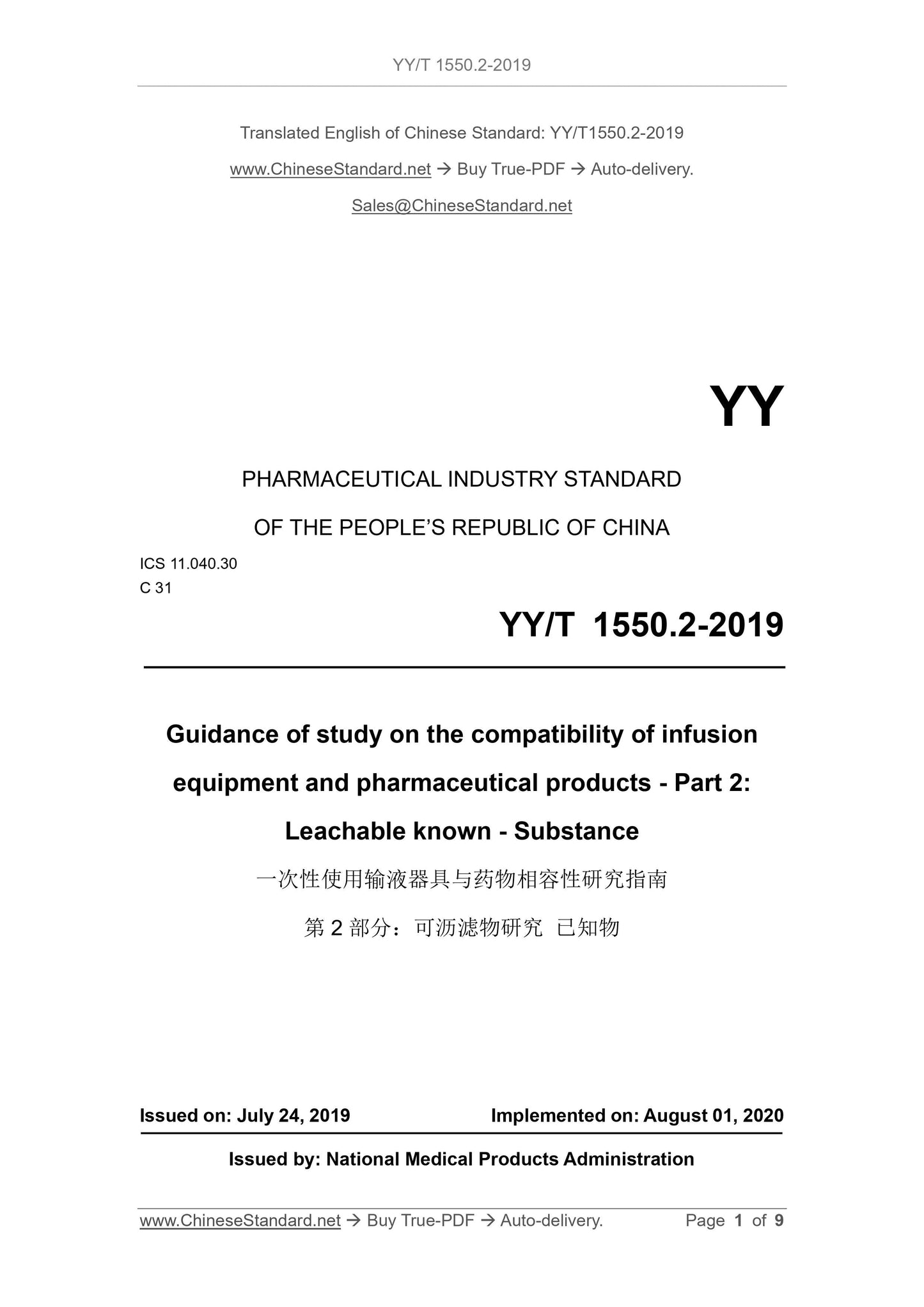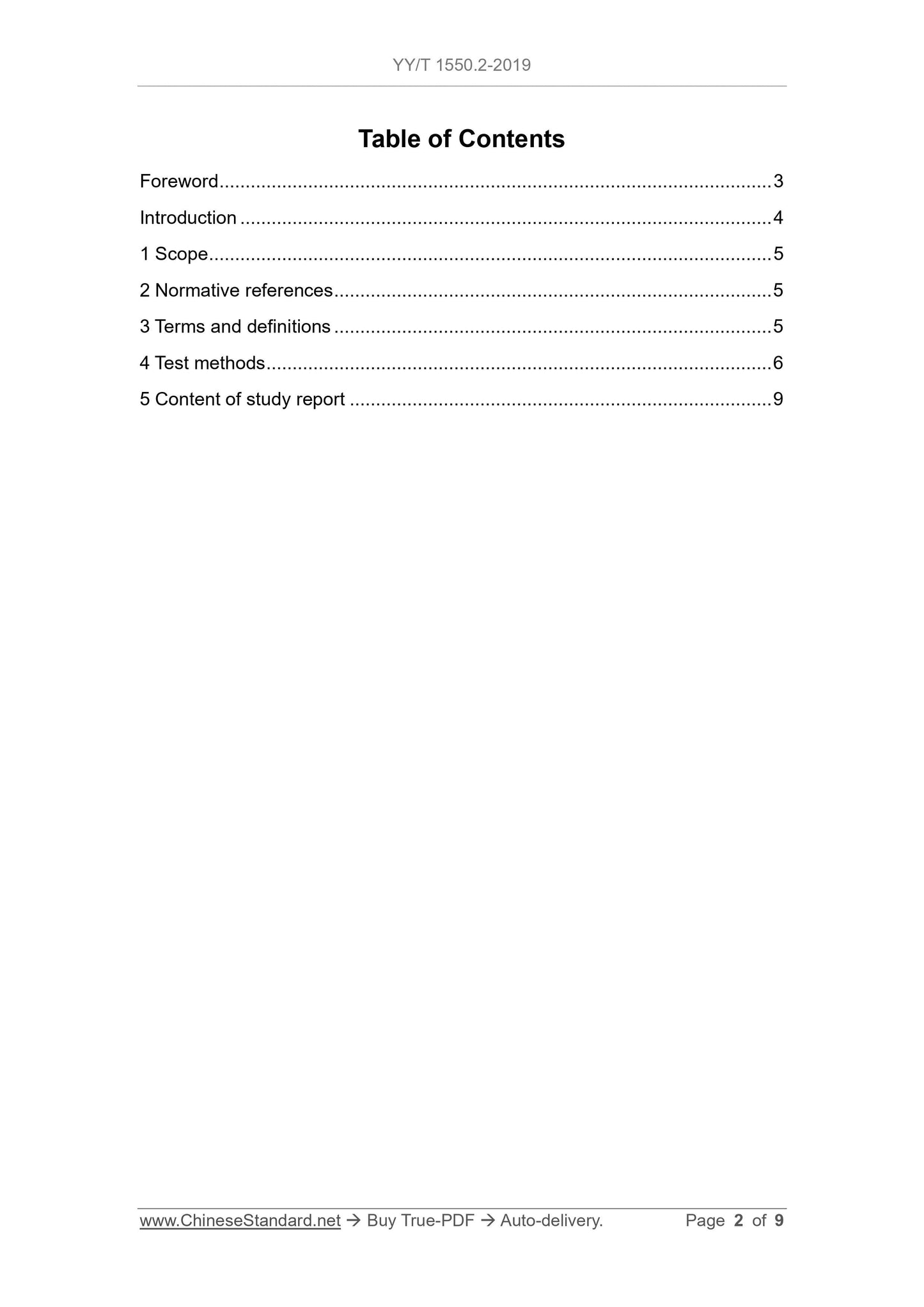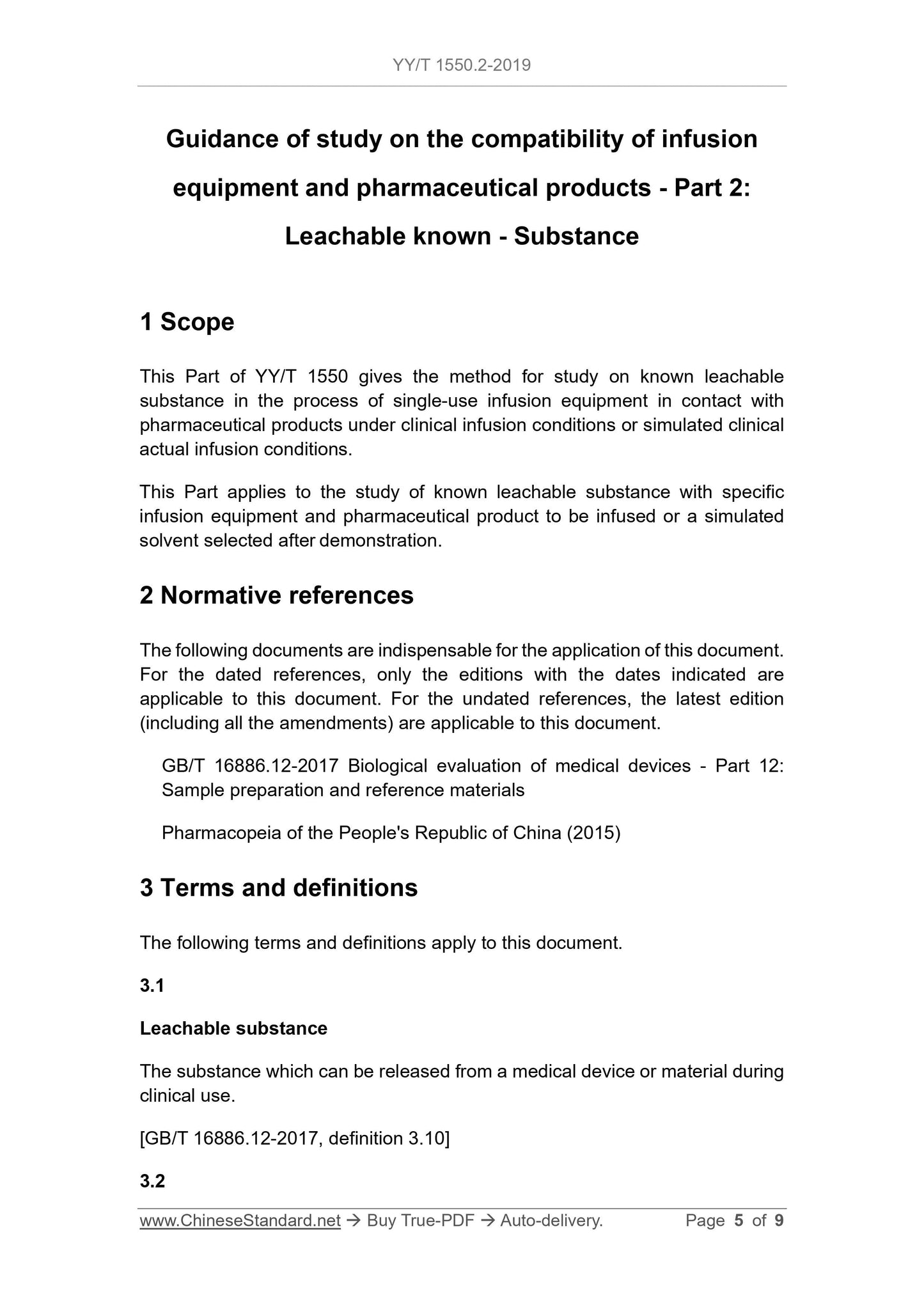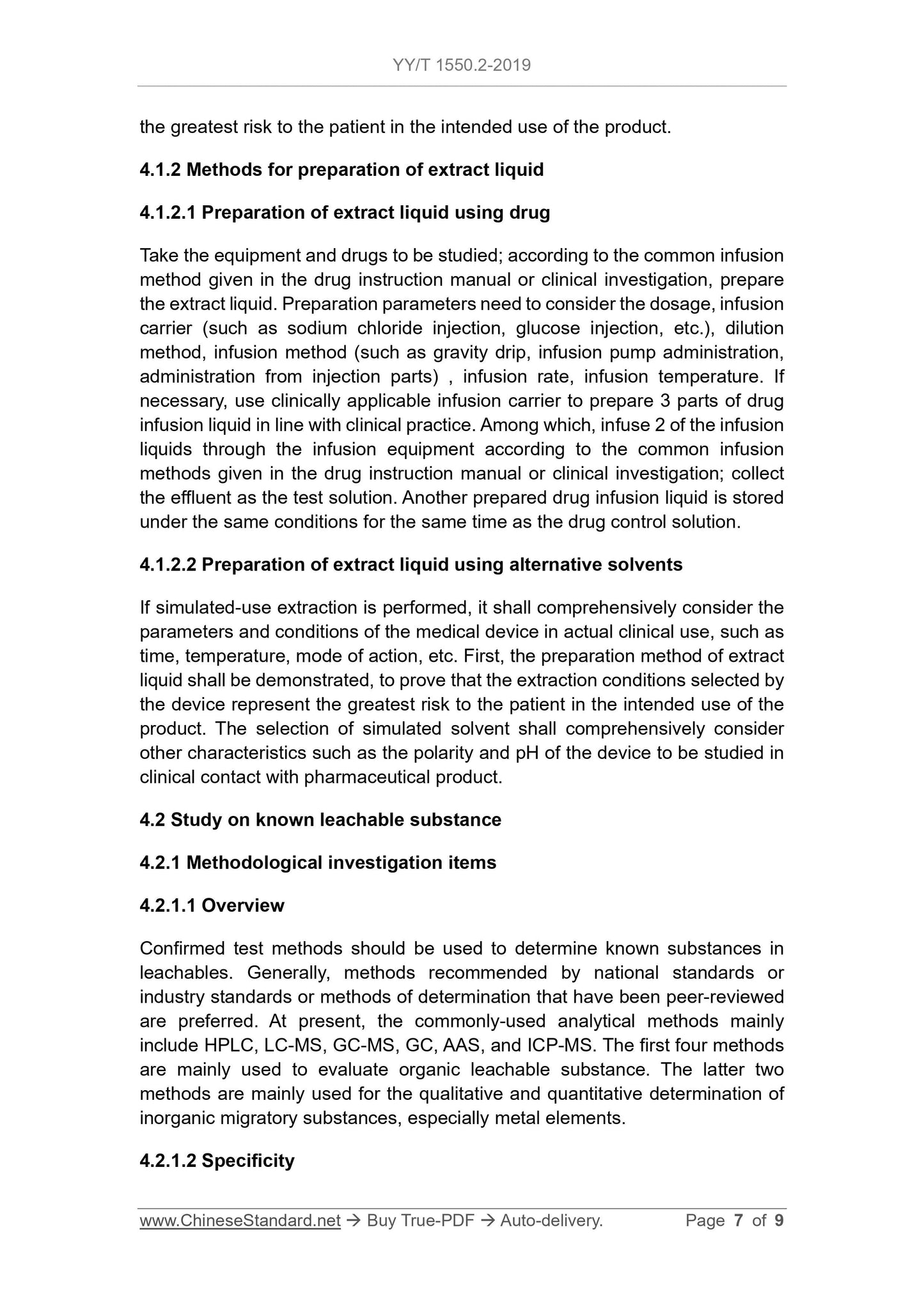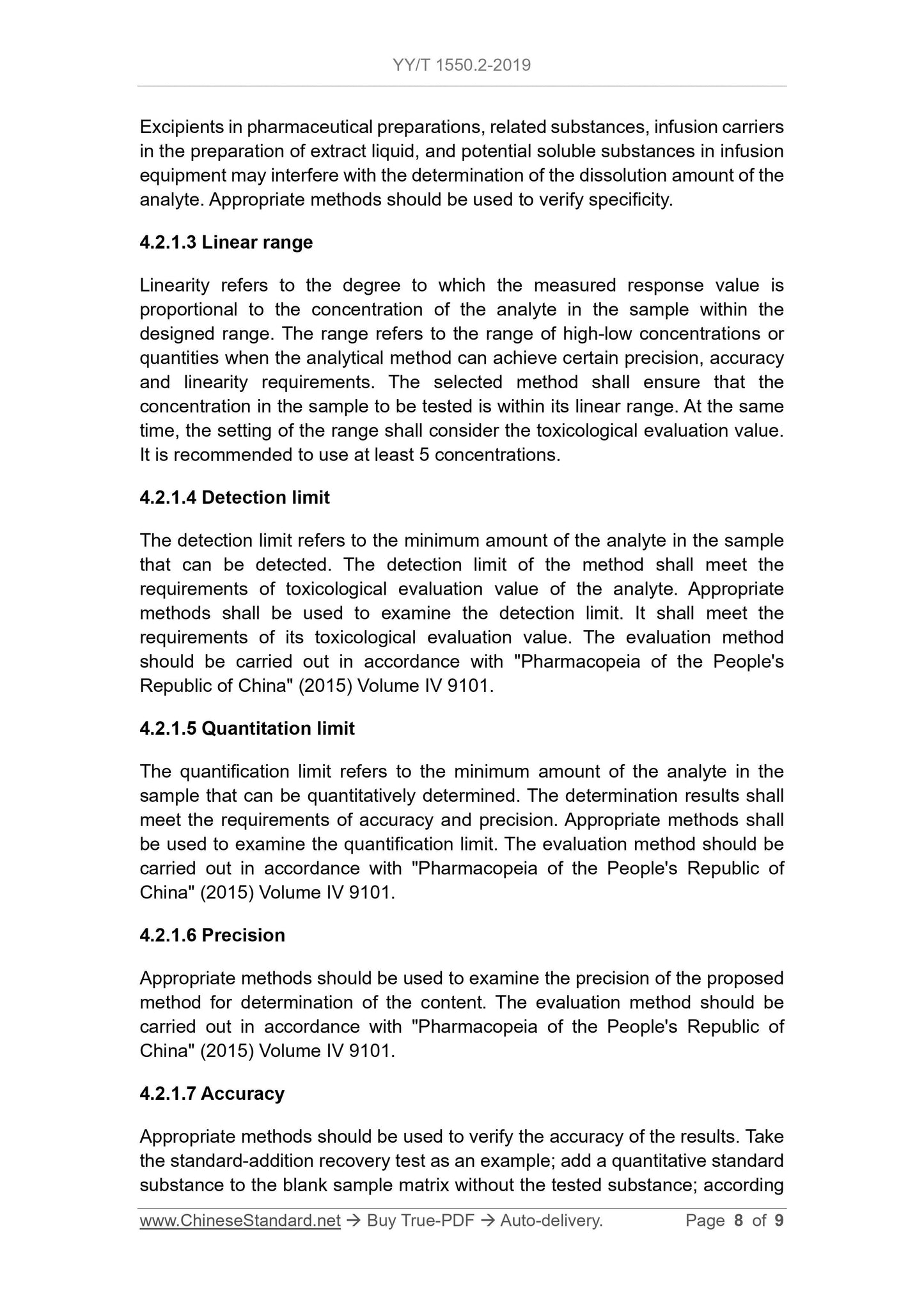1
/
의
5
PayPal, credit cards. Download editable-PDF & invoice in 1 second!
YY/T 1550.2-2019 English PDF (YYT1550.2-2019)
YY/T 1550.2-2019 English PDF (YYT1550.2-2019)
정가
$115.00 USD
정가
할인가
$115.00 USD
단가
/
단위
배송료는 결제 시 계산됩니다.
픽업 사용 가능 여부를 로드할 수 없습니다.
Delivery: 3 seconds. Download true-PDF + Invoice.
Get QUOTATION in 1-minute: Click YY/T 1550.2-2019
Historical versions: YY/T 1550.2-2019
Preview True-PDF (Reload/Scroll if blank)
YY/T 1550.2-2019: Guidance of study on the compatibility of infusion equipments and pharmaceutical products - Part 2: Leachable known - Substance
YY/T 1550.2-2019
YY
PHARMACEUTICAL INDUSTRY STANDARD
OF THE PEOPLE’S REPUBLIC OF CHINA
ICS 11.040.30
C 31
Guidance of study on the compatibility of infusion
equipment and pharmaceutical products - Part 2:
Leachable known - Substance
ISSUED ON: JULY 24, 2019
IMPLEMENTED ON: AUGUST 01, 2020
Issued by: National Medical Products Administration
Table of Contents
Foreword ... 3
Introduction ... 4
1 Scope ... 5
2 Normative references ... 5
3 Terms and definitions ... 5
4 Test methods ... 6
5 Content of study report ... 9
Guidance of study on the compatibility of infusion
equipment and pharmaceutical products - Part 2:
Leachable known - Substance
1 Scope
This Part of YY/T 1550 gives the method for study on known leachable
substance in the process of single-use infusion equipment in contact with
pharmaceutical products under clinical infusion conditions or simulated clinical
actual infusion conditions.
This Part applies to the study of known leachable substance with specific
infusion equipment and pharmaceutical product to be infused or a simulated
solvent selected after demonstration.
2 Normative references
The following documents are indispensable for the application of this document.
For the dated references, only the editions with the dates indicated are
applicable to this document. For the undated references, the latest edition
(including all the amendments) are applicable to this document.
GB/T 16886.12-2017 Biological evaluation of medical devices - Part 12:
Sample preparation and reference materials
Pharmacopeia of the People's Republic of China (2015)
3 Terms and definitions
The following terms and definitions apply to this document.
3.1
Leachable substance
The substance which can be released from a medical device or material during
clinical use.
[GB/T 16886.12-2017, definition 3.10]
3.2
the greatest risk to the patient in the intended use of the product.
4.1.2 Methods for preparation of extract liquid
4.1.2.1 Preparation of extract liquid using drug
Take the equipment and drugs to be studied; according to the common infusion
method given in the drug instruction manual or clinical investigation, prepare
the extract liquid. Preparation parameters need to consider the dosage, infusion
carrier (such as sodium chloride injection, glucose injection, etc.), dilution
method, infusion method (such as gravity drip, infusion pump administration,
administration from injection parts) , infusion rate, infusion temperature. If
necessary, use clinically applicable infusion carrier to prepare 3 parts of drug
infusion liquid in line with clinical practice. Among which, infuse 2 of the infusion
liquids through the infusion equipment according to the common infusion
methods given in the drug instruction manual or clinical investigation; collect
the effluent as the test solution. Another prepared drug infusion liquid is stored
under the same conditions for the same time as the drug control solution.
4.1.2.2 Preparation of extract liquid using alternative solvents
If simulated-use extraction is performed, it shall comprehensively consider the
parameters and conditions of the medical device in actual clinical use, such as
time, temperature, mode of action, etc. First, the preparation method of extract
liquid shall be demonstrated, to prove that the extraction conditions selected by
the device represent the greatest risk to the patient in the intended use of the
product. The selection of simulated solvent shall comprehensively consider
other characteristics such as the polarity and pH of the device to be studied in
clinical contact with pharmaceutical product.
4.2 Study on known leachable substance
4.2.1 Methodological investigation items
4.2.1.1 Overview
Confirmed test methods should be used to determine known substances in
leachables. Generally, methods recommended by national standards or
industry standards or methods of determination that have been peer-reviewed
are preferred. At present, the commonly-used analytical methods mainly
include HPLC, LC-MS, GC-MS, GC, AAS, and ICP-MS. The first four methods
are mainly used to evaluate organic leachable substance. The latter two
methods are mainly used for the qualitative and quantitative determination of
inorganic migratory substances, especially metal elements.
4.2.1.2 Specificity
Excipients in pharmaceutical preparations, related substances, infusion carriers
in the preparation of extract liquid, and potential soluble substances in infusion
equipment may interfere with the determination of the dissolution amount of the
analyte. Appropriate methods should be used to verify specificity.
4.2.1.3 Linear range
Linearity refers to the degree to which the measured response value is
proportional to the concentration of the analyte in the sample within the
designed range. The range refers to the range of high-low concentrations or
quantities when the analytical method can achieve certain precision, accuracy
and linearity requirements. The selected method shall ensure that the
concentration in the sample to be tested is within its linear range. At the same
time, the setting of the range shall consider the toxicological evaluation value.
It is recommended to use at least 5 concentrations.
4.2.1.4 Detection limit
The detection limit refers to the minimum amount of the analyte in the sample
that can be detected. The detection limit of the method shall meet the
requirements of toxicological evaluation value of the analyte. Appropriate
methods shall be used to examine the detection limit. It shall meet the
requirements of its toxicological evaluation value. The evaluation method
should be carried out in accordance with "Pharmacopeia of the People's
Republic of China" (2015) Volume IV 9101.
4.2.1.5 Quantitation limit
The quantification limit refers to the minimum amount of the analyte in the
sample that can be quantitatively determined. The determination results shall
meet the requirements of accuracy and precision. Appropriate methods shall
be used to examine the quantification limit. The evaluation method should be
carried out in accordance with "Pharmacopeia of the People's Republic of
China" (2015) Volume IV 9101.
4.2.1.6 Precision
Appropriate methods should be used to examine the precision of the proposed
method for determination of the content. The evaluation method should be
carried out in accordance with "Pharmacopeia of the People's Republic of
China" (2015) Volume IV 9101.
4.2.1.7 Accuracy
Appropriate methods should be used to verify the accuracy of the results. Take
the standard-addition recovery test as an example; add a quantitative standard
substance to the blank sample matrix without the tested substance; according
Get QUOTATION in 1-minute: Click YY/T 1550.2-2019
Historical versions: YY/T 1550.2-2019
Preview True-PDF (Reload/Scroll if blank)
YY/T 1550.2-2019: Guidance of study on the compatibility of infusion equipments and pharmaceutical products - Part 2: Leachable known - Substance
YY/T 1550.2-2019
YY
PHARMACEUTICAL INDUSTRY STANDARD
OF THE PEOPLE’S REPUBLIC OF CHINA
ICS 11.040.30
C 31
Guidance of study on the compatibility of infusion
equipment and pharmaceutical products - Part 2:
Leachable known - Substance
ISSUED ON: JULY 24, 2019
IMPLEMENTED ON: AUGUST 01, 2020
Issued by: National Medical Products Administration
Table of Contents
Foreword ... 3
Introduction ... 4
1 Scope ... 5
2 Normative references ... 5
3 Terms and definitions ... 5
4 Test methods ... 6
5 Content of study report ... 9
Guidance of study on the compatibility of infusion
equipment and pharmaceutical products - Part 2:
Leachable known - Substance
1 Scope
This Part of YY/T 1550 gives the method for study on known leachable
substance in the process of single-use infusion equipment in contact with
pharmaceutical products under clinical infusion conditions or simulated clinical
actual infusion conditions.
This Part applies to the study of known leachable substance with specific
infusion equipment and pharmaceutical product to be infused or a simulated
solvent selected after demonstration.
2 Normative references
The following documents are indispensable for the application of this document.
For the dated references, only the editions with the dates indicated are
applicable to this document. For the undated references, the latest edition
(including all the amendments) are applicable to this document.
GB/T 16886.12-2017 Biological evaluation of medical devices - Part 12:
Sample preparation and reference materials
Pharmacopeia of the People's Republic of China (2015)
3 Terms and definitions
The following terms and definitions apply to this document.
3.1
Leachable substance
The substance which can be released from a medical device or material during
clinical use.
[GB/T 16886.12-2017, definition 3.10]
3.2
the greatest risk to the patient in the intended use of the product.
4.1.2 Methods for preparation of extract liquid
4.1.2.1 Preparation of extract liquid using drug
Take the equipment and drugs to be studied; according to the common infusion
method given in the drug instruction manual or clinical investigation, prepare
the extract liquid. Preparation parameters need to consider the dosage, infusion
carrier (such as sodium chloride injection, glucose injection, etc.), dilution
method, infusion method (such as gravity drip, infusion pump administration,
administration from injection parts) , infusion rate, infusion temperature. If
necessary, use clinically applicable infusion carrier to prepare 3 parts of drug
infusion liquid in line with clinical practice. Among which, infuse 2 of the infusion
liquids through the infusion equipment according to the common infusion
methods given in the drug instruction manual or clinical investigation; collect
the effluent as the test solution. Another prepared drug infusion liquid is stored
under the same conditions for the same time as the drug control solution.
4.1.2.2 Preparation of extract liquid using alternative solvents
If simulated-use extraction is performed, it shall comprehensively consider the
parameters and conditions of the medical device in actual clinical use, such as
time, temperature, mode of action, etc. First, the preparation method of extract
liquid shall be demonstrated, to prove that the extraction conditions selected by
the device represent the greatest risk to the patient in the intended use of the
product. The selection of simulated solvent shall comprehensively consider
other characteristics such as the polarity and pH of the device to be studied in
clinical contact with pharmaceutical product.
4.2 Study on known leachable substance
4.2.1 Methodological investigation items
4.2.1.1 Overview
Confirmed test methods should be used to determine known substances in
leachables. Generally, methods recommended by national standards or
industry standards or methods of determination that have been peer-reviewed
are preferred. At present, the commonly-used analytical methods mainly
include HPLC, LC-MS, GC-MS, GC, AAS, and ICP-MS. The first four methods
are mainly used to evaluate organic leachable substance. The latter two
methods are mainly used for the qualitative and quantitative determination of
inorganic migratory substances, especially metal elements.
4.2.1.2 Specificity
Excipients in pharmaceutical preparations, related substances, infusion carriers
in the preparation of extract liquid, and potential soluble substances in infusion
equipment may interfere with the determination of the dissolution amount of the
analyte. Appropriate methods should be used to verify specificity.
4.2.1.3 Linear range
Linearity refers to the degree to which the measured response value is
proportional to the concentration of the analyte in the sample within the
designed range. The range refers to the range of high-low concentrations or
quantities when the analytical method can achieve certain precision, accuracy
and linearity requirements. The selected method shall ensure that the
concentration in the sample to be tested is within its linear range. At the same
time, the setting of the range shall consider the toxicological evaluation value.
It is recommended to use at least 5 concentrations.
4.2.1.4 Detection limit
The detection limit refers to the minimum amount of the analyte in the sample
that can be detected. The detection limit of the method shall meet the
requirements of toxicological evaluation value of the analyte. Appropriate
methods shall be used to examine the detection limit. It shall meet the
requirements of its toxicological evaluation value. The evaluation method
should be carried out in accordance with "Pharmacopeia of the People's
Republic of China" (2015) Volume IV 9101.
4.2.1.5 Quantitation limit
The quantification limit refers to the minimum amount of the analyte in the
sample that can be quantitatively determined. The determination results shall
meet the requirements of accuracy and precision. Appropriate methods shall
be used to examine the quantification limit. The evaluation method should be
carried out in accordance with "Pharmacopeia of the People's Republic of
China" (2015) Volume IV 9101.
4.2.1.6 Precision
Appropriate methods should be used to examine the precision of the proposed
method for determination of the content. The evaluation method should be
carried out in accordance with "Pharmacopeia of the People's Republic of
China" (2015) Volume IV 9101.
4.2.1.7 Accuracy
Appropriate methods should be used to verify the accuracy of the results. Take
the standard-addition recovery test as an example; add a quantitative standard
substance to the blank sample matrix without the tested substance; according
Share
